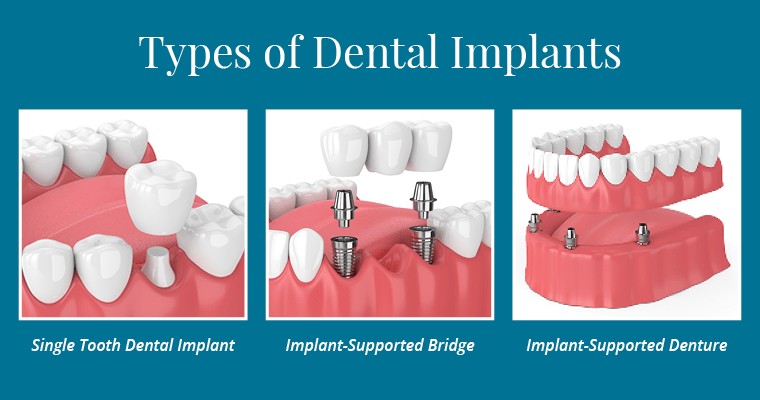Dental Implants for Dummies
Wiki Article
Some Of Dental Implants
Table of ContentsDental Implants Things To Know Before You Get ThisMore About Dental ImplantsAll about Dental ImplantsHow Dental Implants can Save You Time, Stress, and Money.
are clinical gadgets surgically dental implanted right into the jaw to recover a person's ability to chew or their appearance. They supply assistance for synthetic (phony) teeth, such as crowns, bridges, or dentures. When a tooth is lost as a result of injury or disease, a person can experience difficulties such as rapid bone loss, malfunctioning speech, or modifications to chewing patterns that result in discomfort.
Structure of The Oral Implant System choosing dental implants, talk with your dental provider regarding the possible benefits and risks, and whether you are a prospect for the procedure. Points to consider: Your general health and wellness is an essential variable in establishing whether you are an excellent candidate for oral implants, just how long it will take to recover, and the length of time the implant might remain in place.
Smoking might influence the healing process and decrease the long-term success of the dental implant. The recovery procedure for the implant body might take numerous months or longer, during which time you generally have a short-term abutment in area of the tooth. the dental implant procedure: Meticulously adhere to the dental hygiene instructions provided to you by your oral service provider.
Examine This Report on Dental Implants
Implant failure can lead to the requirement for one more procedure to repair or change the implant system. Recovers the capability to chew Recovers aesthetic appearance Aids keep the jawbone from diminishing as a result of bone loss Protects the wellness of the surrounding bone and periodontals Helps maintain surrounding (close-by) teeth steady Improves top quality of life Damage to bordering all-natural teeth throughout implant placement Injury to the surrounding tissues during surgical treatment, such as sinus opening Injury throughout surgical procedure (as an example, fracture of surrounding jawbone) Inadequate function, such as feeling like the teeth do not bite together usually An experience that the tooth hangs or turning in area resulting from a joint screw loosening up Implant body failing (looseness of the implant body) as a result of systemic infection, which might be more probable in Clicking Here clients with unrestrained diabetics issues as a result of local infection in bone and periodontals sustaining the implant body because of postponed healing, which may be more probable in clients that smoke Trouble cleaning up the gum tissues around the implant, leading to inadequate oral hygiene Neglected periodontal disease Post-surgical tingling as a result of nerve impingement or damage Constantly alert healthcare companies and imaging technicians that you have oral implants prior to any kind of magnetic vibration imaging (MRI) or x-ray procedures.FDA is not knowledgeable about any type of damaging events reported for MRI or x-ray treatments with dental implants. Dental implants systems are normally constructed from products that follow worldwide agreement criteria of the International Company for Standardization (ISO) or ASTM International. These standards have details of what makes a risk-free material.
Dental dental implant systems are examined according to global consensus requirements. Biocompatibility screening, to show that physical call with the device does not create difficulties like irritation or sensitive reaction, is component of the assessment that aids guarantee the materials in the dental implant system are risk-free and do not cause damaging effects when implanted in individuals.

Dental Implants Fundamentals Explained
Some people are not eligible for dental implant surgery. It is for dental cosmetic surgeons to operate people with: acute illnessuncontrollable metabolic diseasebone or soft cells illness or infectionIf these concerns are fixed, a person can have the surgical procedure. Dental Implants. In, dental cosmetic surgeons avoid from running on people with: If people with any one of the above undertake dental implant surgery, there is a greater risk of the dental implant failingSome individuals have a jawbone irregularity that protects against enough bone for a dental implant from creating. In such instances, a cosmetic surgeon may need to carry out a ridge alteration. This involves lifting the gum to reveal the area of flawed bone. The doctor will then make use of a bone or bone replacement to repair and develop the area.
Dental implant surgery is a personalized procedure. Offer you time to recover. Attach the blog post and final crown, bridge or denture.
Next, your surgeon will meticulously position the dental implant into your jaw. If your implant is near go to these guys the front of your mouth, your dentist will make a short-lived tooth for you to wear until you recover.
The Basic Principles Of Dental Implants
Your company can inform you what to anticipate in your scenario. During the recovery phase, your jawbone should fuse to the oral implant. This procedure, called osseointegration, is important for stability and long-lasting success. This process can take anywhere from three to 9 months. In many cases, it may take much longer.When your implant heals, your dental professional can affix the joint (little adapter blog post) and your last remediation (crown, bridge or denture). This typically takes regarding one hour to complete and may call for a second minor surgical procedure. You shouldn't really feel any discomfort during your oral implant procedure because your supplier will utilize medication to numb your gums.
Report this wiki page